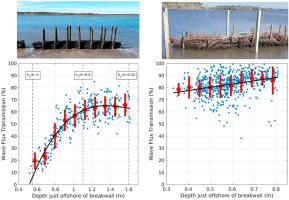当前位置:
X-MOL 学术
›
Cont. Shelf Res.
›
论文详情
Our official English website, www.x-mol.net, welcomes your
feedback! (Note: you will need to create a separate account there.)
Wave transmission through living shoreline breakwalls
Continental Shelf Research ( IF 2.1 ) Pub Date : 2020-12-01 , DOI: 10.1016/j.csr.2020.104268 I. Safak , C. Angelini , P.L. Norby , N. Dix , A. Roddenberry , D. Herbert , E. Astrom , A. Sheremet
Continental Shelf Research ( IF 2.1 ) Pub Date : 2020-12-01 , DOI: 10.1016/j.csr.2020.104268 I. Safak , C. Angelini , P.L. Norby , N. Dix , A. Roddenberry , D. Herbert , E. Astrom , A. Sheremet

|
Abstract Living shorelines are being widely implemented to mitigate shoreline erosion and provide ecosystem services, but how they interact with waves remains poorly understood. Wave transmission through living shoreline breakwalls is studied using field observations and theoretical approaches. The following hypotheses are tested: (i) living shoreline breakwalls can act as buffers against waves; (ii) wave transmission through these nature-based solutions is modulated by tides; and (iii) wave transmission through living shoreline breakwalls is similar to the behavior observed in waves through porous breakwaters. Observations were collected in intertidal settings where boat wakes and tides are the major flow components. Nearly 1000 boat wakes were identified in the observations using advanced time-frequency data analysis methods. Wave transmission through the breakwalls composed of tree branches was quantified and modulation of this process by tides was investigated. The two tested breakwall designs provided different behaviors of wave transmission. In the first design with an estimated porosity of 0.7 where the tree branches were bundled, transmission rates were found to vary mostly between 9% and 70% and had an average of 53%. Transmission increased with increasing water depth especially at mid-tide and low-tide where the height of the breakwall relative to depth was between 0.5 and 1. In the second design with an estimated porosity of 0.9 where the tree branches were not bundled, transmission rates exceeded 70% in 84% of the cases, sometimes reaching 100% transmission, and had an average of 83% with much less variability with depth compared to the first design. Wave transmission estimates based on theory of porous media were found to be most sensitive to breakwall porosity and the friction coefficient. Best agreement between the observed and theoretical estimates of wave transmission was found using a turbulent friction coefficient of 2.7, the median value of the most common range given in the literature on waves through porous media. The highest discrepancy between observed and theoretical estimates of wave transmission occurs at shallow depths when the breakwall emerged. In these conditions, the theory overestimates transmitted wave energy, most likely due to significant wave breaking and bottom friction in shallow water. The findings support our hypotheses that well-engineered semi-porous living shorelines act as buffers against human-mediated boat traffic and waves, and their related performance in dissipating wave energy and sustaining coastal ecosystems is modulated by depth. The results can be used as guidelines for design of living shorelines for given wave climate and breakwall properties.
中文翻译:

通过活的海岸线防波堤的波传输
摘要 有生命的海岸线被广泛实施以减轻海岸线侵蚀并提供生态系统服务,但它们如何与波浪相互作用仍然知之甚少。使用现场观察和理论方法研究了通过活动海岸线防波堤的波浪传输。测试了以下假设:(i) 有生命力的海岸线防波堤可以作为抵御波浪的缓冲器;(ii) 通过这些基于自然的解决方案的波浪传输受潮汐调制;(iii) 通过活的海岸线防波堤的波浪传输类似于通过多孔防波堤观察到的波浪行为。在潮间带环境中收集了观察结果,其中船尾和潮汐是主要的流动成分。使用先进的时频数据分析方法,在观测中确定了近 1000 条船尾迹。通过由树枝组成的防波堤的波传输被量化,并研究了潮汐对这一过程的调制。两种测试的防波堤设计提供了不同的波传输行为。在第一个估计孔隙率为 0.7 的设计中,树枝被捆绑在一起,发现传输率主要在 9% 到 70% 之间变化,平均为 53%。传输随着水深的增加而增加,尤其是在中潮和低潮时,其中防波堤的高度相对于深度介于 0.5 和 1 之间。在第二个设计中,估计孔隙度为 0.9,树枝未捆扎,传输率在 84% 的情况下超过 70%,有时达到 100% 的透射率,平均为 83%,与第一个设计相比,深度变化要小得多。发现基于多孔介质理论的波传输估计对防波堤孔隙率和摩擦系数最敏感。使用 2.7 的湍流摩擦系数发现波传输的观测估计和理论估计之间的最佳一致性,这是文献中关于通过多孔介质的波的最常见范围的中值。当防波堤出现时,波传输的观测值和理论值之间的最大差异发生在较浅的深度。在这些情况下,该理论高估了传输的波浪能量,这很可能是由于浅水中的显着波浪破碎和底部摩擦造成的。研究结果支持我们的假设,即精心设计的半多孔生活海岸线可以缓冲人为干预的船只交通和海浪,它们在消散波浪能和维持沿海生态系统方面的相关性能受深度调节。结果可用作给定波浪气候和防波堤特性的生活海岸线设计指南。
更新日期:2020-12-01
中文翻译:

通过活的海岸线防波堤的波传输
摘要 有生命的海岸线被广泛实施以减轻海岸线侵蚀并提供生态系统服务,但它们如何与波浪相互作用仍然知之甚少。使用现场观察和理论方法研究了通过活动海岸线防波堤的波浪传输。测试了以下假设:(i) 有生命力的海岸线防波堤可以作为抵御波浪的缓冲器;(ii) 通过这些基于自然的解决方案的波浪传输受潮汐调制;(iii) 通过活的海岸线防波堤的波浪传输类似于通过多孔防波堤观察到的波浪行为。在潮间带环境中收集了观察结果,其中船尾和潮汐是主要的流动成分。使用先进的时频数据分析方法,在观测中确定了近 1000 条船尾迹。通过由树枝组成的防波堤的波传输被量化,并研究了潮汐对这一过程的调制。两种测试的防波堤设计提供了不同的波传输行为。在第一个估计孔隙率为 0.7 的设计中,树枝被捆绑在一起,发现传输率主要在 9% 到 70% 之间变化,平均为 53%。传输随着水深的增加而增加,尤其是在中潮和低潮时,其中防波堤的高度相对于深度介于 0.5 和 1 之间。在第二个设计中,估计孔隙度为 0.9,树枝未捆扎,传输率在 84% 的情况下超过 70%,有时达到 100% 的透射率,平均为 83%,与第一个设计相比,深度变化要小得多。发现基于多孔介质理论的波传输估计对防波堤孔隙率和摩擦系数最敏感。使用 2.7 的湍流摩擦系数发现波传输的观测估计和理论估计之间的最佳一致性,这是文献中关于通过多孔介质的波的最常见范围的中值。当防波堤出现时,波传输的观测值和理论值之间的最大差异发生在较浅的深度。在这些情况下,该理论高估了传输的波浪能量,这很可能是由于浅水中的显着波浪破碎和底部摩擦造成的。研究结果支持我们的假设,即精心设计的半多孔生活海岸线可以缓冲人为干预的船只交通和海浪,它们在消散波浪能和维持沿海生态系统方面的相关性能受深度调节。结果可用作给定波浪气候和防波堤特性的生活海岸线设计指南。











































 京公网安备 11010802027423号
京公网安备 11010802027423号